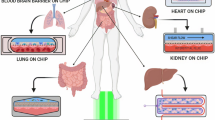Abstract
The margination of a particle circulating in the blood stream has been analyzed. The contribution of buoyancy, hemodynamic forces, van der Waals, electrostatic and steric interactions between the circulating particle and the endothelium lining the vasculature has been considered. For practical applications, the contribution of buoyancy, hemodynamic forces and van der Waals interactions should be only taken into account, whilst the effect of electrostatic and steric repulsion becomes important only at very short distances from the endothelium (1–10 nm). The margination speed and the time for margination t s have been estimated as a function of the density of the particle relative to blood Δ ρ, the Hamaker constant A and radius R of the particle. A critical radius R c exists for which the margination time t s has a maximum, which is influenced by both Δ ρ and A: the critical radius decreases as the relative density increases and the Hamaker constant decreases. Therefore, particles used for drug delivery should have a radius smaller than the critical value (in the range of 100 nm) to facilitate margination and interaction with the endothelium. While particles used as nanoharvesting agents in proteomics or genomics analysis should have a radius close to the critical value to minimize margination and increase their circulation time.
Similar content being viewed by others
References
Becker, F. F., X.-B. Wang, Y. Huang, R. Pethig, J. Vykoukal, and P. R. C. Gascoyne. The removal of human leukemia cells from blood using interdigitated microelectrodes. J. Phys. D: Appl. Phys. 27:2659–2662, 1994.
Bhushan, B. Springer Handbook of Nanotechnology, Heidelburg, Germany: Springer-Verlag, 2004.
Bhushan, B. Introduction to Tribology, New York: Wiley, 2002.
Bhushan, B. Handbook of Micro/NanoTribology, 2nd ed. Boca Raton, Florida: CRC Press, 1999.
Chaudhary, S. S., R. K. Mishra, A. Swarup, and J. M. Thomas. Dielectric-properties of normal and malignant human-breast tissues at radiowave and microwave frequencies. Indian J. Biochem. Biophys. 21(1):76–79, 1984.
Cohen, H. Sustained drug delivery and expression of DNA encapsulated in polymeric nanoparticles. Gene Ther. 7–1896, 2000.
Cooper, G. M. The Cell – A Molecular Approach, 2nd ed.Sunderland, Massachusetts: Sinauer Associates, Inc., 2000.
Decuzzi, P., S. Lee, M. Decuzzi, and M. Ferrari. Adhesion of microfabricated particles on vascular endothelium: A parametric analysis. Ann. Biomed. Eng. 32(6):793–802, 2004.
Dellian, M., F. Yuan, V. S. Trubetskoy, V. P. Torchilin, and R. K. Jain. Vascular permeability in a human tumor xenograft: Molecular charge dependence. Br. J. Cancer 82:1513–1518 2000.
Duncan, R. The dawning era of polymer therapeutics. Nat. Rev. Drug Discov. 2(5):347–360, 2003.
Ferrari, M. Therapeutic Microdevices and Methods of Making and Using Same. U.S. Patent No. 6, 107, 102, 2000.
Ferrari, M., and J. Liu. The engineered course of treatment. Mech. Eng. 44–47, 2001.
Gabriel, C., S. Gabriel, and E. Corthout. The dielectric properties of biological tissues: I. Literature survey. Phys. Med. Biol. 41(11):2231–2249, 1996.
Gabriel, S., R. W. Lau, and C. Gabriel. The dielectric properties of biological tissues: II. Measurements in the frequency range 10 Hz to 20 GHz. Phys. Med. Biol. 41(11):2251–2269, 1996.
Ganong, W. F. Review of Medical Physiology, 21st ed. New York: Lange Medical Books/McGraw-Hill Medical Publishing Division, 2003.
Holmberg, A.Ion exchange tumor targeting (IETT). United States Patent 6, 569, 841, 2003.
Israelachvili, J. Intermolecular and Surface Forces, 2nd ed. New York: Academic Press, 1992.
Jain, R. K. Transport of molecules, particles, and cells in solid tumors. Annu. Rev. Biomed. Eng. 01:241–263, 1999.
Juliano, R. L., and D. Stamp, Effect of particle size and charge on the clearance rates of liposomes and liposome encapsulated drugs. Biochem. Biophys. Res. Commun. 63(3):651–658, 1975.
LaVan, D., T. McGuire, and R. Langer. Small-scale systems for in vivo drug delivery. Nat. Biotechnol. 21(10):1184, 2003.
Liotta, L. A., M. Ferrari, and E. Petricoin. Clinical proteomics: Written in blood. Nature 425:905, 2003.
Martin, F. J., and C. Grove. Microfabricated drug delivery systems: Concepts to improve clinical benefits. Biomed. Microdevices 3:97–108, 2001.
Netti, P. A., T. B. Laurence, Y. Boucher, R. Skalak, and R. K. Jain. Time-dependent behavior of interstitial fluid pressure in solid tumors: Implications for drug delivery. Cancer Res. 55:5451–5458, 1995.
Patri, A. K., I. J. Majoros, and J. R. Baker. Dendritic polymer macromolecular carriers for drug delivery. Curr. Opin. Chem. Biol. 6(4):466–471, 2002.
Pierres, A., A. M. Benoliel, C. Zhu, and P. Bongrand. Diffusion of microspheres in shear flow near a wall: Use to measure binding rates between attached molecules. Biophys. J. 81(1):25–42, 2001.
Raghumand, N., X. He, R. van Sluis, B. Mahoney, B. Baggett, C. W. Taylor, G. Paine-Murrieta, D. Roe, Z. M. Bhujwalla, and R. J. Gillies. Enhancement of chemotherapy by manipulation of tumor pH. Br. J. Cancer 80:1005–1011, 1999.
Rosol, T. J., and C. C. Capen. Biology of disease. Mechanisms of cancer-induced hypercalcemia. Lab. Invest. 67(6):680–702, 1992.
Schirier, W. Renal and Electrolyte Disorders. Philadelphia:Lippincott, Williams and Wilkins, 2003.
Senior, J., J. C. Crawley, and G. Gregoriadis. Tissue distribution of liposomes exhibiting long half-lives in the circulation after intravenous injection. Biochimica et Biophysica Acta 839(1):1–8, 1985.
Tokuyama, M., and I. Oppenheim. Dynamics of hard-sphere suspensions. Phys. Rev. E 50(1):R16–R19, 1994.
Yang, J., Y. Huang, X.-B. Wang, F. F. Becker, and P. R. C. Gascoyne. Differential analysis of human leukocytes by dielectrophoretic field-flow-fractionation. Biophys. J. 78(5):2680–2689, 2000.
Wang, X.-B., Y. Huang, F. F. Becker, and P. R. C. Gascoyne. Non-uniform spatial distributions of both the magnitude and phase of AC electric fields determine dielectrophoretic forces. Biochimica et Biophysica Acta 1243(2):185–194, 1995.
Zhao, Y. H., S. Chien, and S. Weinbaum. Dynamic contact forces on leukocyte microvilli and their penetration of the endothelial glycocalyx. Biophys. J. 80(3):1124–1140, 2001.
Zou, Y., and Z. Guo. A review of electrical impedance techniques for breast cancer detection. Med. Eng. Phys. 25(2):79–90,2003.
Author information
Authors and Affiliations
Corresponding author
Rights and permissions
About this article
Cite this article
Decuzzi, P., Lee, S., Bhushan, B. et al. A Theoretical Model for the Margination of Particles within Blood Vessels. Ann Biomed Eng 33, 179–190 (2005). https://doi.org/10.1007/s10439-005-8976-5
Received:
Accepted:
Issue Date:
DOI: https://doi.org/10.1007/s10439-005-8976-5




